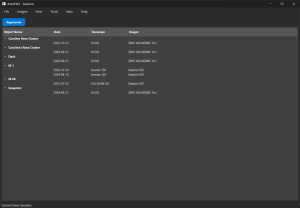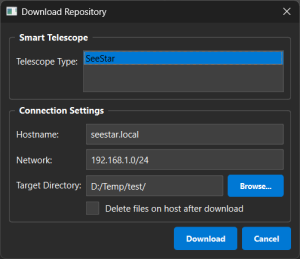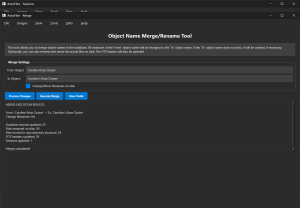If you have FITS files that need to be organized, you should take a look at Astro Filer!
What It IS
From the AstroFile web site:
AstroFiler is a powerful application designed for astronomers and astrophotographers to efficiently manage, organize, and catalog their FITS image files. With an intuitive graphical interface, it provides tools for batch processing, file organization, metadata extraction, session analysis, and direct integration with smart telescopes for seamless data acquisition. Detailed documentation is in the Github Wiki. Astrofiler is a tool to manage FITS files (currently, XISF files and other non-FITS images are coming in the next version!) using FITS header data. FITS Headers are embedded with the image when created as metadata. Astrofiler reads this information to rename the file and file it appropriately in the Repository.
What It's NOT
It is not astro processing software. For that, look here.
Why You Need It
If you have a bunch of FITs files that you need to organize, this does a great job of doing so. Be warned though, it takes things from a source directory and moves/renames them to a destination directory. So your source files will no longer be where they were. Once you get used to this, it's a no-brainer.
How You Install It
I did an an install on Windows.
-
First, you need Python. I got mine from https://www.python.org/ftp/python/3.13.7/python-3.13.7-amd64.exe.
-
You need to install Python with "add to path" for the AstroFile to find it.
-
Download AstroFile from https://github.com/gordtulloch/astrofiler-gui (either from the Releases page or clone the repo if you're familiar with Git). I downloaded the Windows Source ZIP file from the Releases page
-
Expand the ZIP file if needed
-
CD to the new AstroFile directory
-
CD to the install directory
-
Run install.bat or install.ps1 (I did install.bat just to be difficult, but learned later that the BAT files are no longer officiallly supported; run the .PS1 files instead)
-
It worked flawlessly and I chose to have it create a desktop icon
-
Double click the desktop icon
- This failed because the BAT file installation has a typo. Don't do what I did and use the .PS1 install file instead.
- If you insist on using the .BAT file, then you need to edit
\astrofile_laucher.bat and remove the "install\" from the line that says "call install\launch_astrofiler.bat" - The .PS1 files shouldn't have a problem but I didn't test
First Run
Since it wants to move/remove files from their original source locations, I made a copy of some M1, M86, and NGC7789 data to use as a test.
- Point SOURCE at location (in this case, my test data directory, but eventually, you should use your master FITS location)
- Point REPOSITORY at another location (in my case, I used a temp folder on my desktop so source and repository are on different SSDs)
- Images -> Load from Incoming
In my case, it processed 343 files in 3 directories. My NGC7789 data ended up being in two directories - Caroline Rose Cluster and Caroline's Rose Cluster. This may have been my fault for some original naming inconsistencies, but I'm not sure why it's not NGC7789. Will have to figure that out later.
I ended up with this directory tree:
C:\USERS\ASTROPOTAMUS\DESKTOP\ASTROFILE
├───Calibrate
│ └───Dark
│ └───SV503
│ └───ZWO_ASI2600MC_Pro
│ └───0.575
│ └───20240921
└───Light
├───Caroline Rose Cluster
│ └───SV503
│ └───ZWO_ASI2600MC_Pro
│ └───20241022
├───Caroline's Rose Cluster
│ └───SV503
│ └───ZWO_ASI2600MC_Pro
│ └───20240921
├───M 1
│ └───Seestar_S50
│ └───Seestar_S50
│ ├───20240416
│ └───20241020
├───M 86
│ └───S50_454f6183
│ └───Seestar_S50
│ └───20250702
└───Snapshot
└───SV503
└───ZWO_ASI2600MC_Pro
└───20240921Tips
 By going to the View -> Sessions window and regenerating the sessions, it pulled all the session info from the FITS files and figured out how much time I spent doing each target, when, and so forth. That's pretty cool.
By going to the View -> Sessions window and regenerating the sessions, it pulled all the session info from the FITS files and figured out how much time I spent doing each target, when, and so forth. That's pretty cool.
I'm hesitant right now to point it at my complete library, because I haven't figured out why I have two Caroline['s] Rose Cluster directories. And I still need to look more closely at how it renamed the original files. I'm not expecting anything bad, I just want to make sure my 2.5TB of data that I've organized myself over the years doesn't go completely haywire.
"Clear Repository" sounds like it will delete stuff, but it's really just deleting its internal database. You can "Sync Repository" and regenerate sessions again to get back to normal.
If you View -> Images, you can sort based on object or date and filter based on type (light, dark, etc). Once you select an image, you can double click it to open a FITS viewer. I chose ASTAP, which you have to first configure in Tools -> Configuration.
Seestar
 I didn't play with the Seestar directly (I'll update this when I do) but it does have the ability to directly download images from the Seestar. If you have a Dwarf smart telescope, it can do that as well.
I didn't play with the Seestar directly (I'll update this when I do) but it does have the ability to directly download images from the Seestar. If you have a Dwarf smart telescope, it can do that as well.
Google Drive
Version 1.2 is coming with Google Drive integration.
Potential Issues
There is no simple Windows installation file, so if you're not comfortable addition Python to your computer, you might want to wait until later; I'm sure someone will create a Windows installer for it. I didn't check the Linux installation but it should be relatively straightforward there, since Python is already installed in 99.99% of the modern Linux installations. I don't own a Mac to test it with but I suspect it will be a similar install to the Linux one.
For a version 1 software, it's remarkably well written, and works well. Some minor usability things like the merge pull-downs and having things that I think are tools (like Merge) are in the View menu, when I would have expected them in the Tools menu. But I haven't seen anything that destroys my data yet, and it does a good job on moving and rename things.
Conclusions
My first thought is - this is a great tool for organization lots of FITS images. Unfortunately, I'm a OSC user and don't have any filters to configure, so I don't know how well this works with mono imaging and all that goes along with organizing that data. It did pick up that my Seestar data had a LP filter applied, which does show up (N/A for all else), but I didn't see any way to sort or filter based on astronomical filter used. This may be important for some people, but not for me (at this time).
 After writing this quick review, I did find a merge tool that will let me merge/rename my Caroline Rose Cluster session to Caroline's Rose Cluster. This was in the "View" menu, not the "Tools" menu, so I didn't find it at first. I wish it had a pull-down menu for selecting what to move/merge and what the target is, but typing it in manually isn't a big deal.
After writing this quick review, I did find a merge tool that will let me merge/rename my Caroline Rose Cluster session to Caroline's Rose Cluster. This was in the "View" menu, not the "Tools" menu, so I didn't find it at first. I wish it had a pull-down menu for selecting what to move/merge and what the target is, but typing it in manually isn't a big deal.
I am going to play more with this software, and likely bite the bullet and have it organize all of my data (or at least a copy of it, until I'm happy that it's safe). Don't trust me though; play with it yourself!
Until next time, clear skies, and I'll see you in the dark!